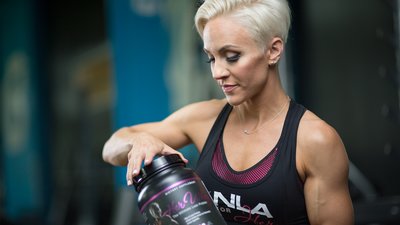For many women, getting motivated to weight train is easier than ever; after all, there are a wide range of health- and physique-related reasons to pick up the iron. Unfortunately, as women, we just don't have the level of anabolic hormones in our body that men do, so building muscle is, and probably always will be, more challenging. This does not mean, however, that it's impossible! It's just going to take a strategic approach.
Here to share some of their best tried-and-true muscle-building tips are the fit beauties from NLA. Listen, learn, and grow!
Eat Enough!
The "eat no more than absolutely necessary" approach won't suffice if you want to add muscle. In fact, figure pro and NLA-sponsored athlete Jessie Hilgenberg says eating enough is one of her top priorities, which is one reason why she leapt at the opportunity to show us what's in her fridge.

Jessie Hilgenberg knows a strong body needs food to fuel it.
"It's all about eating to fuel your muscles," she says. "A lot of us can't get over that hurdle of gaining muscle, because we simply aren't eating enough to support and maintain growth."
She likes using the IIFYM (if it fits your macros) approach, as it allows her to figure out the best formula that fits her body. "It breaks it down into how much protein, carbs, and fat you should be eating for your activity level," Hilgenberg explains, "and often, it's more than you think!"
Do the Splits
There's nothing wrong with full-body workouts. Many women are able to build appreciable muscle by training every major muscle group a few times a week, especially when they first start. But if your total-body approach isn't taking or has plateaued, it might be time to try a body-part split.
This is what finally worked for NLA athlete and bikini competitor Theresa Miller, which is why she advises hitting each main muscle group alone for maximum intensity. "It's important to come up with a good weekly training schedule that best suits you and your body type and goals," she says. "I like to devote specific days to focus on certain muscle groups such as shoulders, back, and legs."

Theresa Miller organizes her workouts into body-part splits to target problem areas.
There are many ways you can organize your split. For example:
- 2-4 workouts a week: Push/pull (squats and pressing motions one day, pulling motions the next)
- 2-4 workouts a week: Upper body; lower body
- 3 workouts a week: Legs; push; pull
- 4 workouts a week: Chest and triceps; back and biceps; legs; shoulders and abs
Here's the catch: These workouts should still be hard! Embrace the challenge, and find out what #legday is all about. It could be just the thing to take your results to the next level.
Cut Back the Cardio
When you increase calories and protein, it can be tempting to up your cardio as well. After all, you don't want to gain the wrong type of weight, right? Jessie Hilgenberg says that mental trap might be just the thing that's holding you back. "You don't need to spend hours doing cardio—especially when you're looking to add muscle," she says.
It can help to think of it this way: Every calorie you burn on the treadmill is one that your body won't use to build muscle. If you're looking for a challenge to replace all that cardio, Hilgenberg advises hopping into the squat rack and pushing new limits rather than continuing to submit to your old ones.
Lift Heavy
For NLA athlete and bikini pro Amy Updike, results came when she started really adding weight to the bar. "I try to lift the heaviest weight I can while still maintaining proper form and reaching the range of 8-12 reps per set," she explains. "Heavier weight for me means the muscle has to grow in order to lift it."

Amy Updike continually pushes herself to lift more weight.
Don't expect to get a lot stronger overnight, though. Slowly add weight to the bar, giving your body a chance to rise to the challenge. While you may not add weight to every lift in each workout you do, you should see a gradual upward trend. If it's been six months and you are still using the same weights, consider this a clear sign that you need a change of approach.
Get Serious About Your Form
When you're doing endless reps with tiny light weights, you can get away with sloppy form. That changes once you commit to lifting heavier. Form needs to become a top priority!
"Don't get sloppy," advises Miller. "Always do slow, controlled movements when hitting each rep. This will help you feel the movement and the burn in the right places.
One great thing about that 8-12 rep range is that it is low enough to help you gain some strength, but high enough that you'll feel that crucial mind-muscle connection—the feeling that helps you ensure you're working the right muscle fibers and getting the most from each exercise you do.
Snack on Protein
Most effective muscle-building nutritional approaches share two rules that go hand in hand: "get enough calories" and "get enough protein."
"I have found that when I eat plenty of protein throughout the day on a regular basis, my muscles are able to utilize the protein and grow most effectively," says Updike. "Without enough protein in my diet, my muscles cannot repair and grow."
This doesn't mean you have to go the "eat a dozen identical meals a day" route. It could just mean that each meal contains a solid protein source, and when you snack, make sure it's a protein-rich snack. Those two choices can make a huge difference.
Take Rest Days Seriously
One nice thing about following body-part splits or other lifting programs is that they have programmed rest days. The bad thing? Sometimes you don't want to rest, or you feel like it's going to be a step back. Hilgenberg insists this isn't the case.

"Giving your muscles the opportunity to recover is key," she says. "It's easy to try to work the muscles heavily in an effort to make them grow, but you have to be careful of overworking your muscles—particularly if you're hitting individual muscle groups hard."
She recommends setting aside a day or two each week where you limit yourself to only light activity—a walk, anyone?—and take a break from all lifting. "During this time, you are giving your muscles the opportunity to repair, and in return, this will cause growth."
Train to Technical Failure
Read about training online, and you'll see "failure" discussed a lot in various forms. The term you need to remember is "technical failure." This means that by the time the set is finished, you can't complete another rep using good form.
This sends your muscles an unmistakable message to grow, and it's precisely what Updike does to help enhance her results. "I try to lift as intensely and heavy as possible so that I am literally failing and unable to do more reps by the end of most sets, and almost always the last set of every exercise," she explains. "This fully fatigues the muscle, breaking it down and leading to more repair and growth."
Just to be clear, this doesn't mean pushing yourself so hard that you barely survive each set! You shouldn't be squeezing out extra reps using poor form to hit your target rep range. If that's the case, it's time to lighten the weight so you can manage with better form.
Sure, it can be hard to find that sweet spot between intensity and safety. But once you do, you'll be setting yourself up for success. When that happens, do what these women did and share the wealth with our readers!


